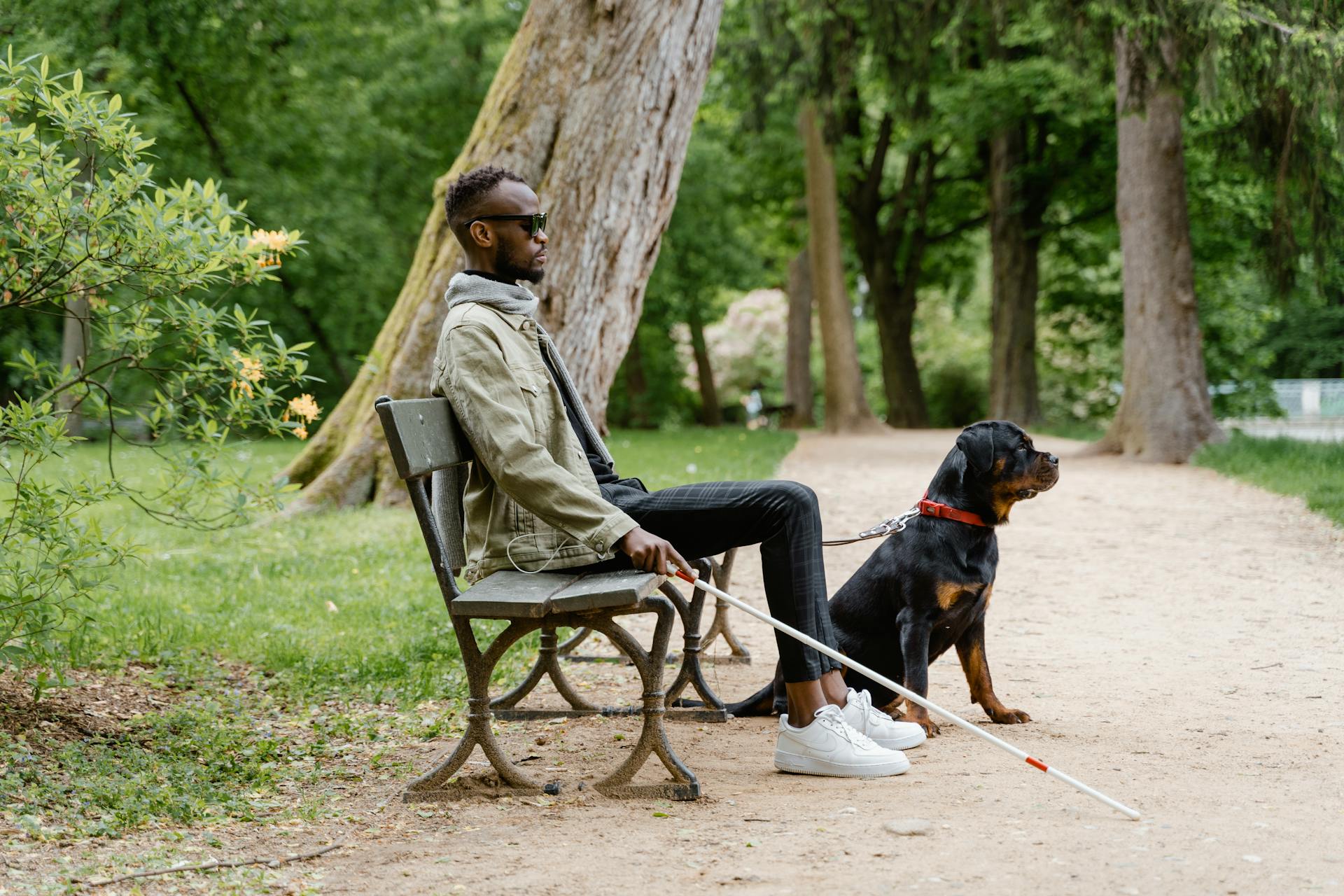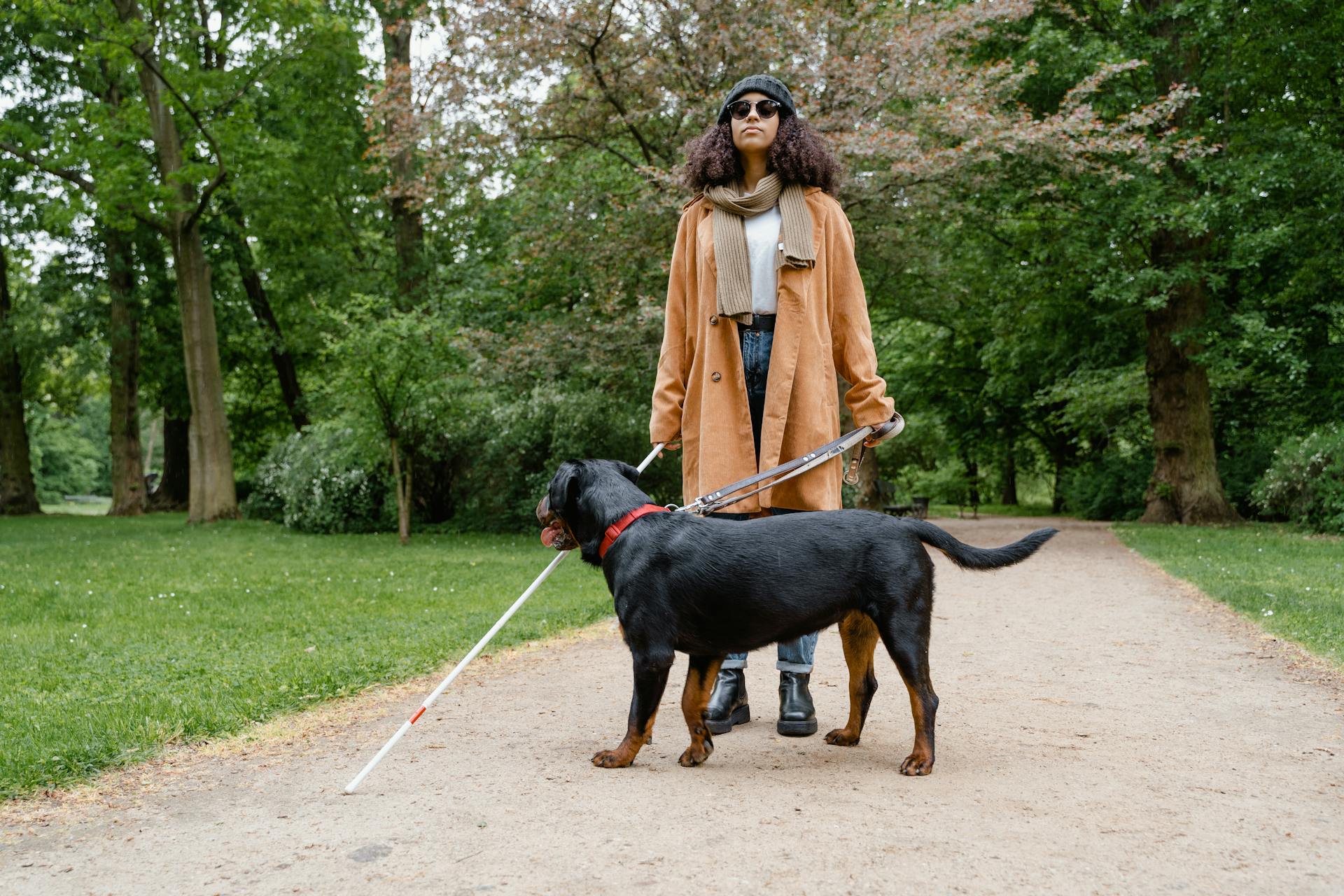
In Canada, service dogs play a vital role in assisting individuals with various disabilities. They are highly trained to perform specific tasks, such as guiding the blind, alerting the deaf, or providing physical support.
To qualify for a service dog in Canada, individuals must have a legitimate disability that impacts their daily life. This can include conditions such as diabetes, epilepsy, or post-traumatic stress disorder.
Service dogs in Canada are protected under the Canadian Human Rights Act, which prohibits discrimination against individuals with disabilities. This means that businesses and organizations must allow service dogs to accompany their owners in public spaces.
Service dogs are trained to behave in public and respond to their owner's needs, but they are not pets and should not be treated as such.
If this caught your attention, see: Dogs in Canada
Eligibility and Requirements
To be eligible for a service dog in Canada, a dog must have been individually trained by an organization or person specializing in service dog training.
These trainers provide specialized training to help the dog perform a task that assists a person with a disability with a special need related to their disability.
In order to meet the requirements, the service dog must be trained to perform a specific task that addresses the person's disability.
Here's an interesting read: Trained German Shepherds Family Protection
Emotional Support Animals
Emotional support animals are not the same as service dogs, which receive special training to perform specific tasks for people with disabilities. They don't have the same certifications or status as service dogs.
Major Canadian carriers can refuse to accept emotional support animals on board, in which case regular animal (pet) travel rules and fees may apply.
Expand your knowledge: Service and Emotional Support Dogs
Requirements
To own a service dog in Canada, you need to meet specific requirements. A service dog must be individually trained by an organization or person specializing in service dog training.
The dog must perform a task to assist a person with a disability with a special need related to their disability. This task can be anything from opening doors to providing physical support.
Check this out: Do Service Dogs Need to Be Registered
Service Dogs in Canada
Service dogs in Canada are highly trained animals that assist individuals with disabilities.
In Canada, service dogs are protected under the Canadian Human Rights Act and the Accessibility for Ontarians with Disabilities Act.
For more insights, see: Ada Rules for Service Dogs
Service dogs can be trained to assist people with a wide range of disabilities, including mobility issues, visual impairments, hearing impairments, and mental health conditions.
Service dogs must be trained to a high standard and are recognized by a special vest or ID card.
Service dogs are allowed to accompany their owners in all public places, including restaurants, stores, and public transportation.
In Canada, service dogs are not required to wear a special harness or vest, but it is recommended to avoid any confusion.
For another approach, see: Is a Public Access Test Required for Service Dogs
Facility and Travel
Traveling with a service dog in Canada is relatively straightforward, as most major carriers are required to accept service dogs for on board transportation free of charge.
You'll want to plan ahead, though, as the Canadian Transportation Agency (CTA) has a guide that outlines the regulations and requirements for service dogs on public transportation. This includes information on adjacent seating, dog relief areas, and security screening.
To ensure a smooth trip, check the CTA's website for a reservation checklist and important information on service dogs. You can also learn more about the costs covered by the Canadian Armed Forces for service dogs accompanying military personnel.
A different take: Canadian Breeds of Dogs
Visiting a Canadian Defence Facility

If you're planning to visit a Canadian defence facility with a service dog, you'll need to submit an accommodation request to the appropriate DND manager or CAF unit commanding officer.
You can find more information in the Defence Administrative Orders and Directives, specifically DAOD 2005-0, Service Dogs, and DAOD 2005-1, Service Dog Access to Defence Establishments.
If you have questions about service dogs and defence establishments, you can contact the CAF base or support unit or the units, squadrons and ships.
A different take: Canine Tens Unit
Travelling
Traveling with a service dog can be a bit tricky, but don't worry, I've got you covered. Most major carriers in Canada are required to accept service dogs for free, but it's essential to plan ahead.
You should check the CTA's website for a reservation checklist and important information on traveling with a service animal, including space for your dog and dog relief areas. This will help ensure a smooth trip.

Some carriers in Canada may also provide adjacent seating without charging extra fees, but you'll need to confirm this with them in advance. It's always better to be safe than sorry.
If you're traveling internationally, be prepared to provide more information and potentially pay a fare or charge for an additional seat. The Canadian Armed Forces Relocation Directive can help you understand the costs covered for service dogs in certain situations.
Training and Certification
You'll attend On Campus training with us at our facility in Oakville, Ontario, where you'll meet your new canine Teammate and learn about handling, caring for, and bonding with your dog.
Depending on the program, you'll stay with us for 10-21 days to gain the confidence and skills you need to leave as a new Team. Our Program Instructors will be on site to support you, answer questions, and help you every step of the way.
Alternatively, you can choose to self-train a service dog, but be aware that this can be a challenging process, especially when it comes to finding moral and local support.
A fresh viewpoint: Bully Breed Ban Us
On Campus Training

On Campus Training is a crucial part of our program, where you'll get to meet your new canine Teammate and learn how to care for them.
You'll receive an invitation to attend On Campus training approximately 6-8 weeks in advance, and it's usually a 10-21 day program.
Our Program Instructors will be on site with you during class time, supporting you, answering questions, and helping you gain the confidence and skills you need to bond with your dog.
You'll spend your time learning about handling your dog, caring for your dog, and practicing together in the comfort of our Training Facility.
This hands-on experience will help you build a strong relationship with your dog, and our instructors will be there to guide you every step of the way.
Here's an interesting read: Boarding My Dog for the First Time
Make You an Animal
You can train your dog to become a service dog, and it's a great way to have a loyal companion by your side. According to the International Association for Assistance Dog Partners (IAADP), you can train your dog to perform any type of service dog task you need.
Choosing the right breed is a crucial step in service dog training. Pick a breed that will best fit to mitigate your disability and work with you. If you want to raise and train a puppy or adolescent for future service work, you should choose one with the temperament for the job.
You'll need to find a training structure or solution to correct the dog's bad behavior in training, which can be challenging. Many owner-trainers have gone through the frustrating experience of spending numerous hours on the telephone gathering or receiving information only to find that they offer a limited perspective on a complex field.
The Online Certified Intensive Service Dog Training Course can be a good option for professional training support and guides. This course provides a simple yet comprehensive step-by-step guide to service dog training so you can successfully train your own service dog.
As a service dog handler, you're responsible for keeping control of the dog at all times. This means being prepared to handle situations where the dog may not behave as expected, like if it leaves urine or feces in a public place.
You're also liable for any damages caused by the service dog, so it's essential to take responsibility for your dog's actions.
For more insights, see: Dog Work
Frequently Asked Questions
Do you need a doctor's note for a service dog in Canada?
In Canada, a doctor's note is not always required for a service dog, but you must provide a note from a regulated health professional if the animal's purpose is not immediately apparent. Visual indicators like vests or harnesses can also be used to identify service dogs.
What is the difference between a service dog and a support dog in Canada?
In Canada, service dogs are trained to perform specific tasks to support people with disabilities, whereas emotional support animals do not receive specialized training and have different legal status. Service dogs are certified and recognized under Canadian law, while emotional support animals are not.
Sources
- https://www.canada.ca/en/ombudsman-national-defence-forces/education-information/caf-members/health/guide-travel-assistance-animal.html
- https://www.dogguides.com/programs/service/
- https://www.servicedogtrainingschool.org/blog/service-dog-canada
- https://www.canada.ca/en/department-national-defence/corporate/policies-standards/defence-administrative-orders-directives/2000-series/2005/2005-0-service-dogs.html
- https://woundedwarriors.ca/our-programs/ptsd-service-dogs/
Featured Images: pexels.com


